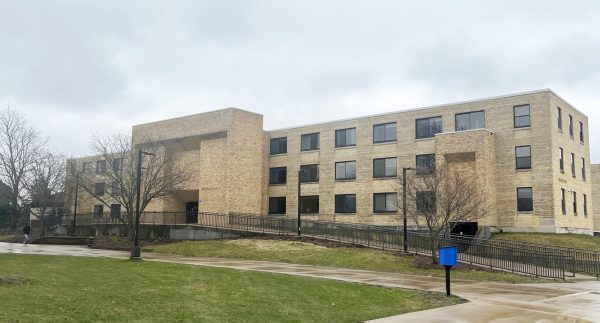Regents to approve budget cuts
The chancellor’s latest plan only addresses $4.4 million of the target $10 million budget reduction goal for the university due to possible statewide cuts.
Chancellor Dennis J. Shields submitted his proposed annual campus budget for the 2015-2016 fiscal year to the UW System Board of Regents on April 15. $3.7 million of the $4.4 million is projected savings made possible through reductions including position cuts and transfers, which were not specified. The remaining $1.5 million comes from possible additional revenues, including $900,000 in increased tuition from the Tri-State Initiative.
These cuts and plans for projected revenues will take place over three phases and will include raising Tri-State Initiative tuition by $600 per student, eliminating 22 positions and transferring 23 positions on campus.
Legislative process
The University’s Budget Reduction Planning Process stated the next step is for the UW System Board of Regents to approve the proposed budget before finalizing it July 9.
At the beginning of February the biennium budget was proposed by incumbent Gov. Scott Walker, indicating the UW System could possibly face a $150 million cut each year over the next two years. The proposal could cause the UW System to lose 25 percent of its annual state-funded budget.
Those involved in higher education have criticized the proposed budget since its release. The new budget proposal concerns cutting state funding to a multitude of programs, including funding for the Great Lakes Bioenergy Research Center while allowing pay raises for Wisconsin State Troopers.
Daniel Suhr, chief of staff of Wisconsin Lt. Governor Rebecca Kleefisch, said the $300 million would be cut from the overall $36 billion state budget, forcing UW System universities to make cuts within programs and departments.
Stated on the UW System website, the state of Wisconsin provides $1.2 billion to the System in funding, which would be cut down to $900 million to be split among 14 UW System campuses. The UW System has an annual budget of $6 billion, with 20 percent of the budget coming from state funding.
Prior to showing a budget proposal to the legislators, different state agencies submit a wish list of what they want for state aid and funding, Suhr said. This list is sent to Gov. Walker to compare and contrast with his wish list items; eventually proposing a budget that is presented to the legislature and public of Wisconsin before any vote is made. During the creation of Gov. Walker’s wish list, he consults with the Legislative Fiscal Bureau, a nonpartisan agency consisting of different legislatures from Wisconsin, which presents a list of projected revenues for the state over the biennium and an updated list of growth in revenue.
“Legally, Gov. Walker has to produce a balanced budget,” Suhr said.
With the proposed budget, state agencies testify to the Joint Committee on Finance about why they should receive the amount of state funding they requested and discuss different arguments about the impact on the proposed funding.
“The feedback most legislators are getting is that the cut proposed by the governor is too large, and they want to scale that back,” Shields said. “There are a number of other entities competing for additional state funding.”
After legislators listen to the different agencies, the Joint Committee on Finance goes through the proposed budget topic by topic to make changes and decide how much money will be allocated and where, prior to holding a floor session in May.
“Late April, early May, the Legislative Fiscal Bureau will re-estimate revenues and at that point the legislature may see that they have more [state revenue] than the governor projected-or less,” Robert Cramer, UW-Platteville Vice Chancellor of Administrative Services, said.
Suhr said the Joint Committee on Finance will send the budget with the new changes in early May for legislators to vote on.
The proposed budget may or may not be passed by the legislature in May, depending on whether or not they believe the budget needs to be further examined. Suhr said once the budget is passed, Walker signs the 2015-2017 budget to take effect July 1 of this year.
On the day of signing, Gov. Walker has the power to line-item veto or partial veto any portions of the bill he does not want.
“He [Gov. Walker] can make any partial veto during signing,” Suhr said.
The hopes are to get the final budget voted on by Memorial weekend, Suhr said. The budget bill for 2014 was not signed by Gov. Walker until June 29, two days before the following budget year would start.
“The language in the governor’s budget does indicate to the Boards of Regents [what] would be subject to future budget cuts,” Cramer said.
Effect on UW-Platteville
At the March 10 and 11 Budget Open Forum meetings, Shields discussed the possible $5 million deficit the university could face from the state and the $5 million structural deficit.
“We will essentially try to achieve both a $5 million cut and the governor’s budget, which is a little bit of a moving target,” Shields said.
The target goal for UW-Platteville was a reduction of $10 million, with items identified through the consulting of different campus governance groups, including Faculty Senate and Student Senate.
The Budget Reduction Form, home to different plans and possible cuts, is an Excel spreadsheet giving information on what could possibly be cut in order to meet the proposed $5 million in state cuts. The form was created by the campus senates, and reviewed by Shields and campus and community members offered comments. Different items are highlighted into different categories; green meaning the cut is recommended, yellow meaning a recommended possible cut and red meaning the cut is not recommended.
“We are going to plan for $5 million and hope that the legislature changes the budget so it’s a little less than that,” Shields said.
On April 8, 2015, four Democrats on the Joint Finance Committee sent a letter to the co-chairs of the JFC, including stated recommendations for increased funding of public and system schools, the SeniorCare program and investment in the State Park System.
As stated in the letter, the Wisconsin senators request that the governor “prevent the $150 per pupil cut to local public schools, raise the per pupil revenue cap, eliminate the expansion of taxpayer subsidies to private voucher schools and restore the $300 million cut to the UW System.”
Wisconsin Budget Revenues
According to a March 5 document from Bob Lang, Director of the Legislative Fiscal Bureau, “under the Governor’s 2015-2017 budget bill, the gross general fund balance would be $123.0 million and the net balance would be $58 million.”
In earlier reports, Wisconsin was facing a $2.2 billion deficit, which was pointed at the tax cuts during Walker’s first term as governor.
“We cut taxes by over $2 billion,” Suhr said. “A typical Wisconsin family in a typical Wisconsin home [valued at approximately $150,000] would see $381 in their pocket they didn’t see before.”
The $381 is equivalent to an additional $7.32 per week, which is roughly two Starbucks coffees a week.
“I think the legislature is going to be waiting until late April to make any big budget decisions in anticipation of the revenue projections that come out around that time,” Shields said.













